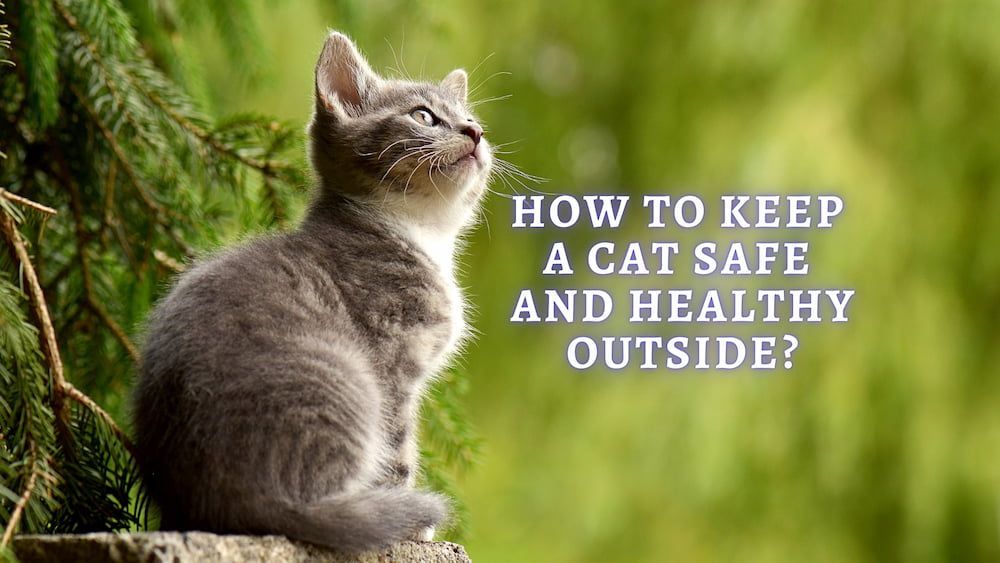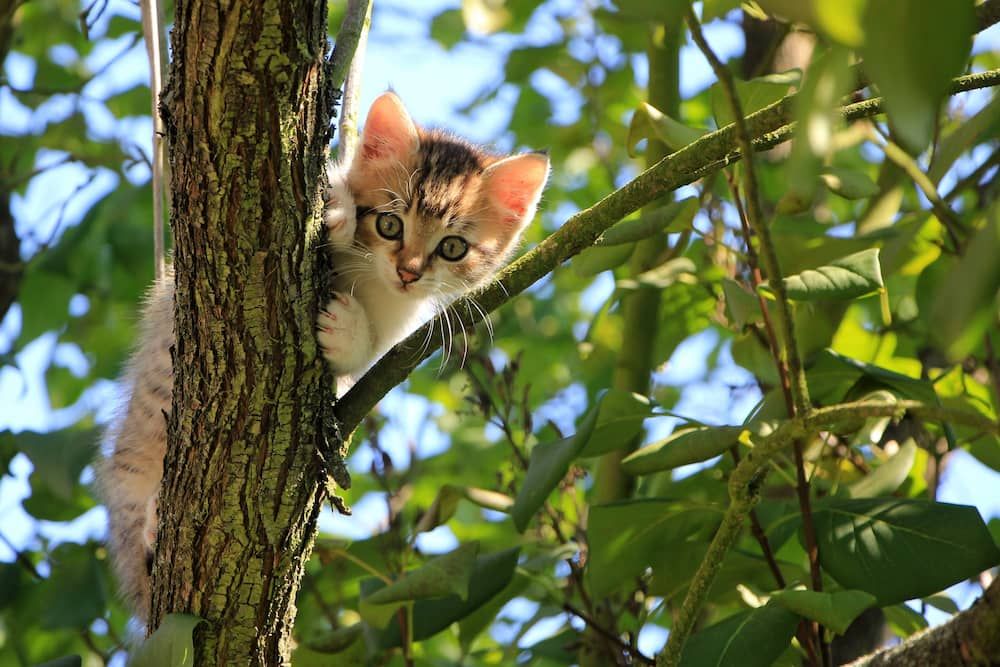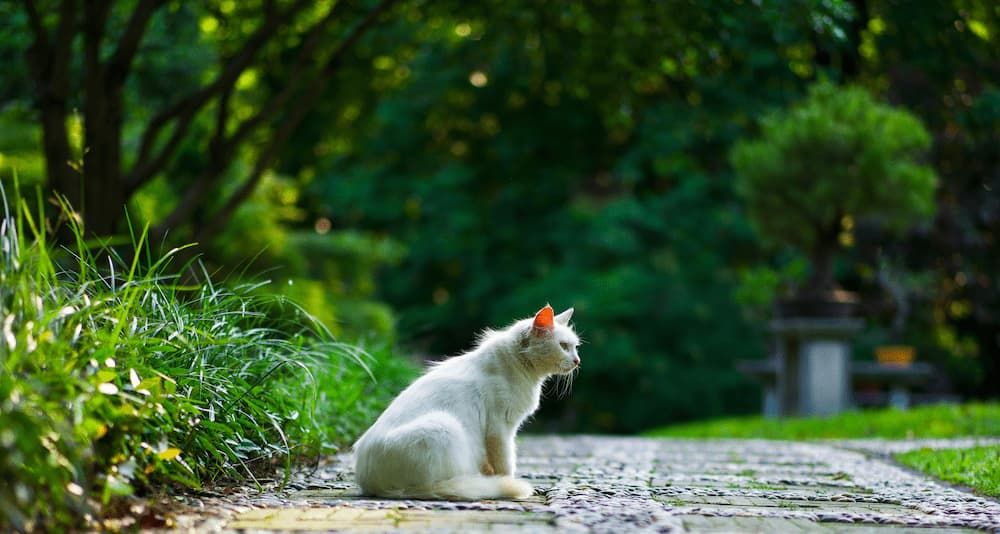How to Keep Your Cat Safe and Healthy Outside?
Written by:
Author: Vicki Smirnova
Vicki Smirnova is a professional writer and editor who adores animals and helps readers get along well with their pets. She has been working in digital media for more than 5 years and has great experience writing content about lifestyle, including pets. Vicki specializes in dog health and nutrition, cat feeding, dog training. She is an aquarium lover and is passionate to write about fish care at home. Also, Vicki headed several websites and worked as a news editor.
View all 245 articlesLearn about our editorial process and veterinary review board.
Viewed: 142
Updated on: 03/23/2022
Even experienced cat owners often wonder whether or not to let their pets outside. When weighing the pros and cons, it’s important to keep two things in mind: First, all cats are different, with individual character traits and preferences. So, what’s suitable for one pet isn’t necessarily good for yours; for example, if you took a stray cat that led a homeless lifestyle, it will most likely want to be outside. On the other hand, if a pet has had a negative experience with other outdoor animals, it may not want to go out again. Both indoor and outdoor pets can live whole and happy lives, provided that you take appropriate measures and make the indoor or outdoor space as safe and exciting as possible.[1]
Does your Pet long for freedom?
Cats love to climb, run, explore and catch various creatures to bring as a gift to their owner. While felines are biologically suited to the outdoors, it may be dangerous for a domestic pet. Understanding the potential risks will help keep your furry friend safe. Here is our guide to letting your companion roam.
Some pets benefit from time spent in the yard or roaming the neighborhood. Outdoor exercise keeps pets healthy and strong and helps them satisfy some of their natural urges and behaviors.
You can help improve their lives by minimizing some of the more obvious outdoor threats.
Make sure you microchip!
According to the American Society for the Prevention of Cruelty to Animals, every year around 10 million dogs and cats are lost [4] in the US – tragically, only around 2 percent of pets are ultimately returned to their owners. A pet risks getting lost when it is unfamiliar with its surroundings. It may also struggle in the unfamiliar territory if it wanders a little too far from its regular haunts. Thus, microchipping is a good idea, as it helps identify your furry friend if it roams, and it is the only real hope you have of it coming back to you if it gets lost.
Some people put collars on their pets and this is fine. A collar is a useful way to identify a cat as a pet and not a stray. But they do sometimes get caught on branches or other hazards when a cat is climbing. Make sure your furry friend’s collar is quick-release to ensure it gets free if snagged.
Ease your pet outside
Don’t open the door the first day you take your furry friend home from the shelter. Adjust your pet to its new surroundings by keeping it inside for at least three weeks. Then, it has the best chance to lay lots of scent down in your home, which makes it easier to find its way back.
Insurance is a must!
No pet parent wants to consider the possibility of accidents and injuries affecting their furries. But as a parent, you need to be responsible. If your furry friend is going outside insurance covers you for the unexpected. Pet insurance, like, for example, the Lemonade pet health insurance, includes coverage for diagnostics, procedures, and medication as a result of illness or accidents.
Prevent pet fights
Male cats should be neutered to help cut down levels of aggression that can cause those cat fights that wake you up in the middle of the night. Cat fights are almost inevitably outdoor cats who often share their territory and conduct gang wars to decide who is the alpha pet. While you can’t stop your pet from fighting, you can make sure it has the best chance of health by keeping up its vaccinations.
Protect against disease
This last point is especially important. Get all the correct vaccinations before your cat goes outdoors. You can protect your feline from the most common pet diseases when it has its up-to-date shots, including kitten shots. Remember that cats need regular boosters to ensure protection. Keep up with your appointments for a happy pet and keep your pet’s medical record up to date.
Remember roads!
Busy roads and outdoor felines do not mix well. Your furry friend may love chasing rodents at night, but headlights and fast cars are disorienting, and more pets are hurt or killed in the dark on roads. Keep your cat indoors at night, if possible. Try shutting the door immediately after they have their last meal of the day. You can also time lunch for busy times on the road.
Keep cats safe in the sun and cold
White-furred pets are more susceptible to the sun’s rays and can get sunburned in the summer. Cat sunscreens are available but are likely to be licked away. Keeping your pet indoors during the hottest parts of the day is a better idea.
Cold weather is also problematic. Provide indoor access for an outdoor pet with a cat flap or a space in a warm shed with a bed and a water source.
Should I let my Cat Outside?
Ultimately, the decision to let your pet roam outside or keep it indoors is up to you. Keeping cats inside has many advantages, including a lower chance of contracting contagious illnesses, reduced risk of accidents and incidents and a decreased chance of losing it to theft or escape.
Consider the positive and negative aspects of letting a pet outside.
Pros
Cons
- Cats that can walk on their own have more opportunities for physical activity. They can climb trees, jump, run and explore new places and objects. In addition, your cat will be less likely to gain weight if it can walk freely outside or just explore the limited space in the fresh air.
- The cat is entirely free to follow its instincts outside, such as sharpening its claws.
- The open space offers a curious cat many opportunities to explore unknown places, smells, tastes and surfaces. This will give the pet new experiences that will stimulate natural curiosity and improve mood.
- In addition to the usual indoor tray for rainy days and nighttime, you can arrange an extra toilet space in a safe corner of the garden.[2]
- One of the most serious threats to outdoor pets is cars; especially dangerous are busy highways, but even on a quiet country road, a pet can get hurt or get very scared. Another risk – the pet can hide under the hood of a car.
- The cat may go too far and get lost. Do not use regular collars to avoid the risk of loss. Instead, the appropriate-sized safety collar is equipped with an identification medallion and can be undone by itself if necessary.
- Depending on where you live, foxes, coyotes, dogs, and other aggressive cats may pose a potential threat to your pet.
- Cats walking on the street are more likely to become infected with diseases, especially due to fights with other cats.[3]
However, most pets live a fuller life when they are allowed access to open space. You can minimize the risk to your beloved pet by following our tips to get the best of both worlds – freedom for your feline and peace of mind for you.
READ MORE: How Much Exercise Does a Cat Need?
FAQs
Why does my Cat want to go outside?
Cats are, by nature, quite curious and love to explore the unknown. Cats are attracted to interesting places, sounds, tastes, surfaces and smells that they may encounter on the street.
Is it cruel to keep a Cat outside?
If your cat goes outside in the cold, then low temperatures can harm it. Pets that go outside in winter should be adapted to walking and to the changed weather. To adapt the pet to low temperatures, its fur becomes thicker and does not freeze, and the body develops winter immunity.
How do I protect my outdoor Cats from predators?
Sterilize your cat so that its instincts do not guide it. Never leave a kitten alone on the street, even for a minute. It will not be able to defend itself in the event of an attack by other animals.
How to keep a Cat warm outside?
Usually in the fall, cats actively shed in order to get a high-quality coat with a thick undercoat for the winter. Permanent residence in warm conditions may prevent this. You can buy a pet warm clothes.
When can my Cat go outside after being neutered?
Until the stitches are removed and the veterinarian assesses the state of healing, do not let the pet outdoors, since the pet can touch the seam, scratch the wound and/or cause an infection. When the wound heals and the skin is intact, the pet can go outdoors.
Article Sources:
- Driscoll, Carlos A., et al. “From Wild Animals to Domestic Pets, an Evolutionary View of Domestication.” PubMed Central, ncbi.nlm.nih.gov/pmc/articles/PMC2702791/.
- “Are Pet Allergies the Same as Outdoor Allergies?” Animal Planet, 26 Feb. 2015, animalplanet.com/pets/healthy-pets/pet-outdoor-allergies/.
- Chemical Exposures: Cats as Sentinel Species; Carol Potera; Environ Health Perspect. 2007 Dec; 115(12): A580.; https://www.ncbi.nlm.nih.gov/pmc/articles/PMC2137107/
- “Every Day Is Tag Day” — Is Your Pet Protected?” American Humane, 1 June 2021, americanhumane.org/blog/every-day-is-tag-day-is-your-pet-protected/.
 Cat Care Why Does My Cat Stare At Me? Cats Behavior and Body Language Explanation
Cat Care Why Does My Cat Stare At Me? Cats Behavior and Body Language Explanation - 189
- 0
 Cat Care Why Does My Cat Attack My Legs? 10 Reasons Why and What To Do About It (Vet-Approved Advice)
Cat Care Why Does My Cat Attack My Legs? 10 Reasons Why and What To Do About It (Vet-Approved Advice) - 45080
- 21
 Cat Veterinary Tips Cat Stomach Gurgling: Vet Advice on Why is Your Cat Stomach Gurgling?
Cat Veterinary Tips Cat Stomach Gurgling: Vet Advice on Why is Your Cat Stomach Gurgling? - 33729
- 4
 Cat Veterinary Tips My Cat Lost its Voice: Can Cats get Laryngitis? (Vet Advice)
Cat Veterinary Tips My Cat Lost its Voice: Can Cats get Laryngitis? (Vet Advice) - 22889
- 13

























